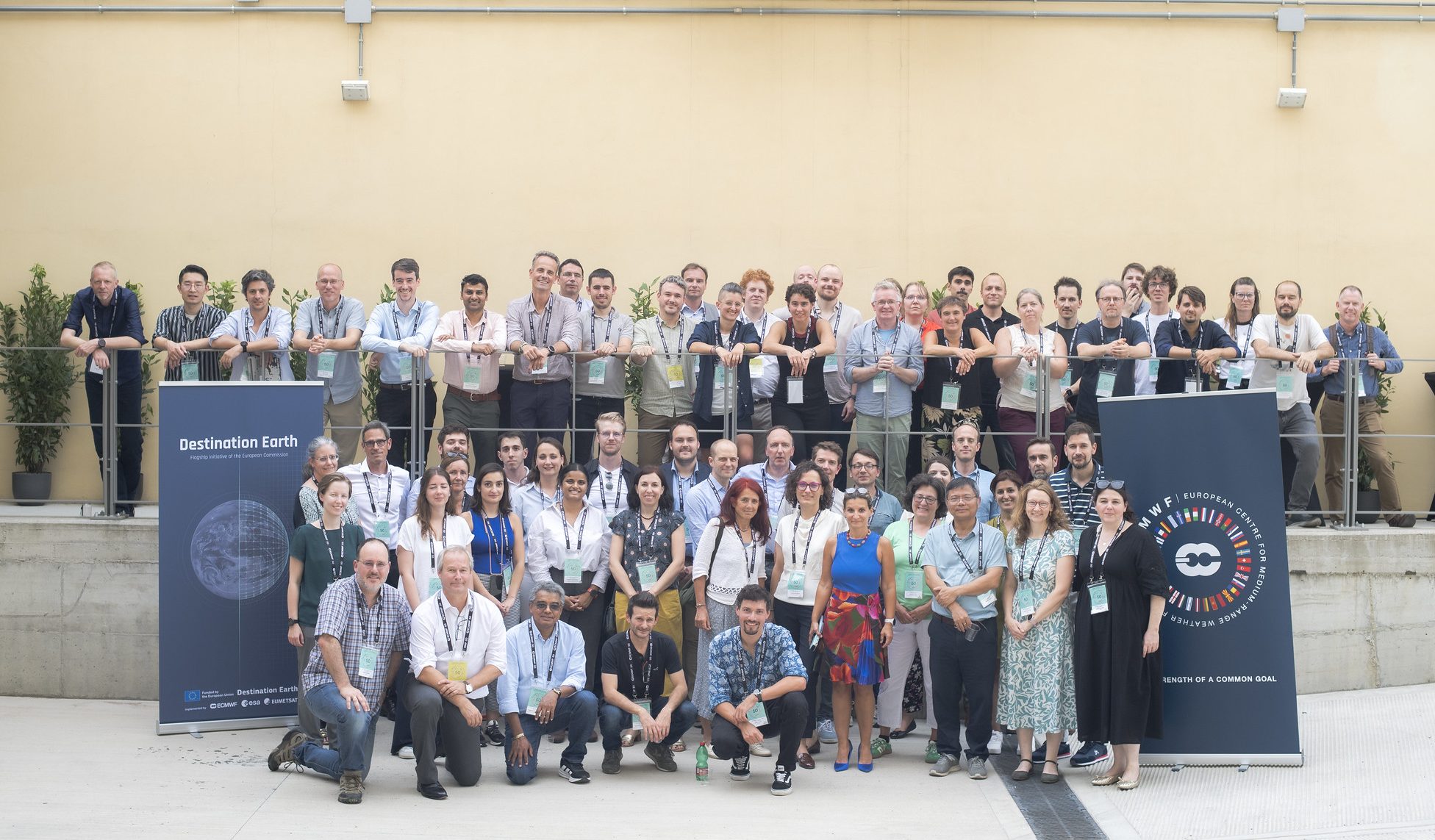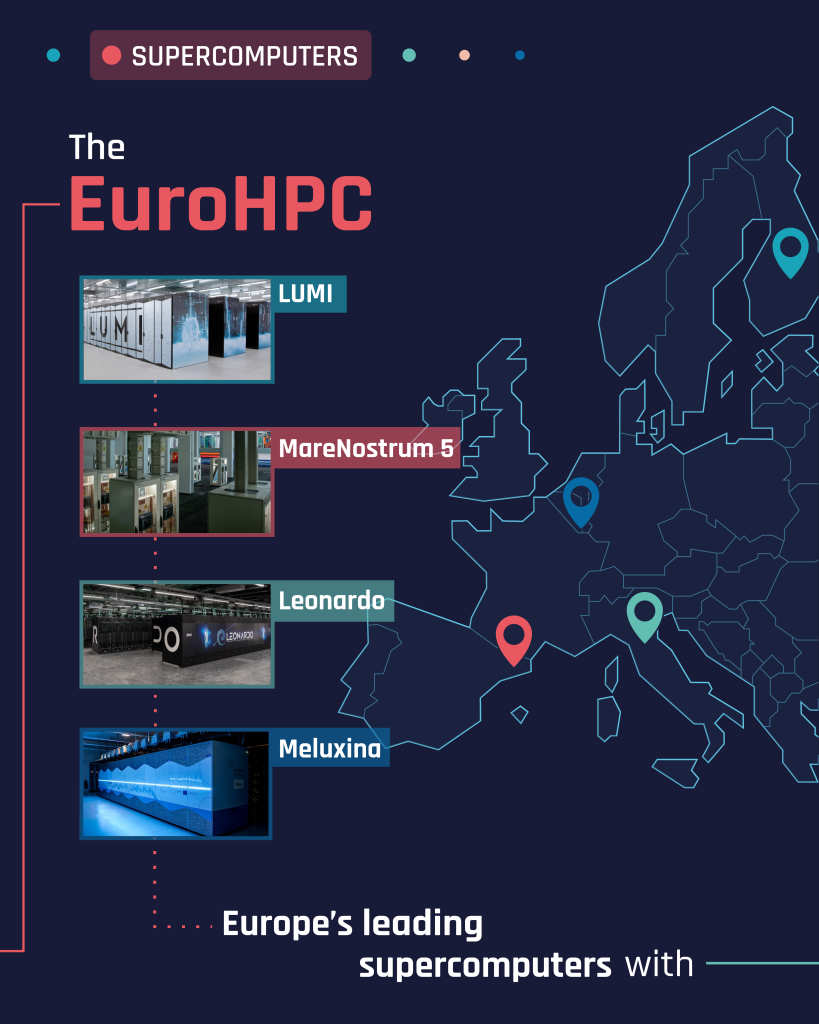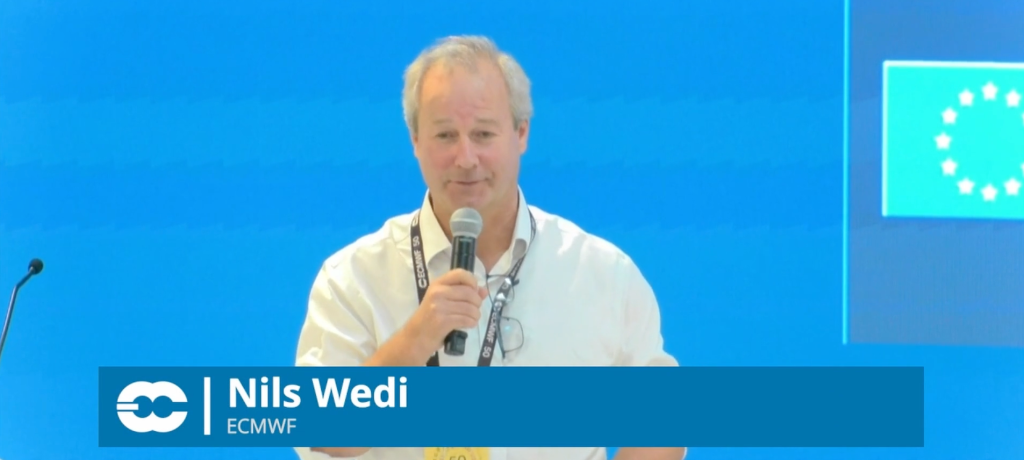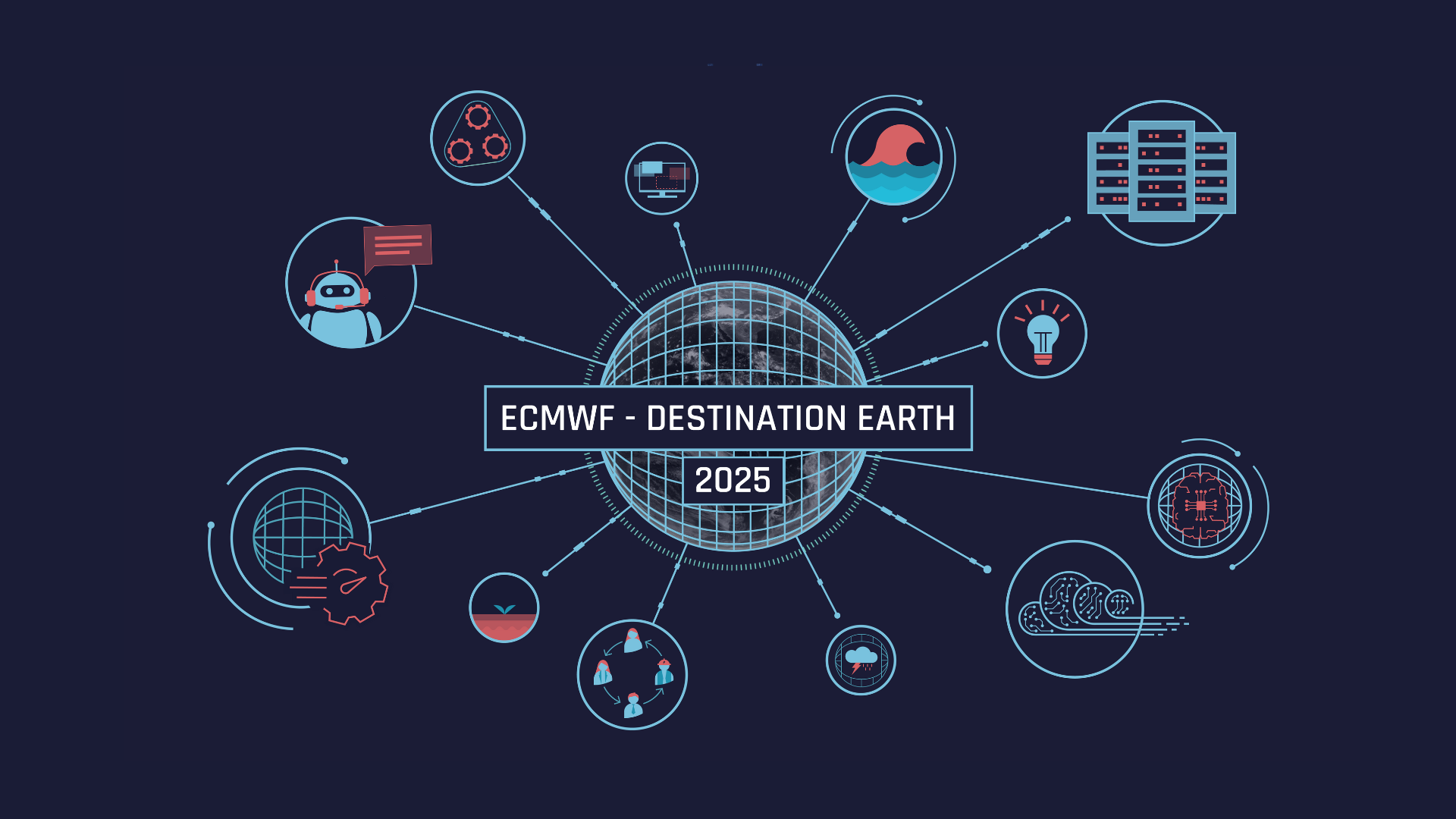
The third ECMWF Destination Earth (DestinE) Annual Meeting took place on 16-17 September 2025 at the DAMA – Tecnopolo di Bologna. The gathering brought together around 80 participants from the partner institutions working together with ECMWF to implement the digital twins, digital twin engine and a broad range of artificial intelligence (AI) activities within the DestinE initiative of the European Union. The meeting highlighted the excellent progress made over the last year, spotlighting in particular exciting first results obtained with the prototype AI based Earth system model components.
ECMWF’s 50th anniversary celebrations
DestinE’s Annual meeting took place as part of a wider week of celebrations marking the European Centre for Medium-Range Weather Forecasts (ECMWF) 50th anniversary. Also hosted during the week were the 21st HPC Workshop, the ‘Using ECMWF Forecasts event, and the ‘European Weather Cloud User Workshop.’
Celebrations in Bologna were the second in a series of three events, dedicated to marking ECMWF’s half century. The first was held at ECMWF’s Bonn site (7-11 April), with the final event hosted at ECMWF’s headquarter in Reading (1-3 December). The anniversary year is also marked by a series of publications about ECMWF’s activities.
The DestinE Annual Meeting took advantage of the ECMWF 50th anniversary celebrations to engage with the wider community.
Irina Sandu, Director for DestinE at ECMWF, said: “Bringing the DestinE community together during ECMWF 50th anniversary, share insights and learn from one another was an important and inspirational moment. The progress achieved over the past three years is truly exceptional and reflects the outstanding quality and dedication of the people and organisations driving this effort.”
Video summary of the 3rd DestinE Annual Meeting
The DestinE and EuroHPC strategic partnership – a key enabler
DestinE is funded by the European Union and implemented by three entrusted entities: ECMWF, the European Space Agency (ESA), and the European Organisation for the Exploitation of Meteorological Satellites (EUMETSAT), under the leadership of the Directorate-General for Communications Networks, Content and Technology (DG CNECT). More than 100 organisations and institutions from across Europe are involved as part of ECMWF’s commitment to delivering the digital twins and Digital Twin Engine, as well as a wide range of AI activities.

Grazyna Piesiewicz, Head of Unit at DG CNECT for High Performance Computing and Applications, opened the joint session between the DestinE meeting and the HPC workshop, celebrating both the 50 years of ECMWF and over four years of Destination Earth. She praised the work of both ECMWF and DestinE, an initiative in which she was involved since the start. “Destination Earth has now become a familiar feature on the EuroHPC scene, and from the European Union, we are very proud to showcase Destination Earth as one of the greatest examples of the benefits of our investments in European HPC and how we can benefit not only in the pursuit of science but also resulting in concrete, tangible outcomes for all citizens. It is a prime example of a hugely collaborative endeavour of the top strategic importance for Europe”.
The implementation of DestinE is enabled by a strategic partnership with the European High Performance Computing Joint Undertaking (EuroHPC JU), which provides access to unprecedented computing power through several of its pre-exascale supercomputers and now also through the first exascale supercomputer in Europe, Jupiter. The other systems used are LUMI in Finland, Leonardo in Italy, MareNostrum5 in Spain, and MeluXina in Luxembourg.

Josephine Wood, Head of Unit of Strategy and Governance at EuroHPC JU, also speaking at the HPC workshop, praised DestinE as an excellent use case example for EuroHPC JU, since it exemplifies both the value of European investments in HPC and how these translate into benefits for the society. Wood also explained how much DestinE is exploiting the powerful EuroHPC machines, using 6,484,570 node hours of CPUs and 4,163,772 node hours of GPUs between 2023 and 2025. She also celebrated that the DestinE achievements are recognised internationally with the recent inclusion on the ACM Gordon Bell Prize for Climate Modelling 2025 shortlist and two HPCWire Reader’s Choice Awards in 2024.
In the keynote talk of the joint session, Nils Wedi, Digital Technology Lead for DestinE highlighted the achievements of ECMWF and its numerous partner organisations around Europe in implementing digital twin technology for the Earth system, a global first, and expanding AI capabilities exploiting recent advances. Nils Wedi also gave an overview of the latest developments in the Climate Change Adaptation Digital Twin (Climate DT), the Weather-induced Extremes Digital Twin (Extremes DT) and the Digital Twin Engine.

Fostering European collaboration
Collaboration is paramount for the implementation of DestinE and this was reflected throughout the programme of the annual meeting.
“These exchanges are essential elements of co-developing the digital twins and the Digital Twin Engine, as well as for the AI activities ECMWF is implementing. The ECMWF Annual Meetings for DestinE focus on an in-depth exchange between the partners involved in making DestinE happen – from the Digital Twins to impact sector applications and AI. The impact sector value has been showcased via use cases and now pilot services and machine learning demonstrators. These ensure that we really understand the needs of critical sectors such as energy, water management or agriculture at a technical level,” said Jörn Hoffmann, Application Partnerships Lead at ECMWF for DestinE, that led a Panel Discussion on User Needs.
ECMWF partners involved in the Pilot Services and ML Demonstrators were onsite in Bologna, delivering insightful pitches on how different sectors can benefit from digital twin data. Learn more about the Pilot Services and ML Demonstrators here.
The implementation of DestinE digital twins stems from a broad collaborative effort, building on the long-standing collaborative tradition in the European weather and climate prediction communities, closely related to the high-performance computing ecosystem. The rapid advances in artificial intelligence and machine learning for weather forecasting and climate are the latest example of the strength of this highly collaborative European approach.
Continued progress on the digital twin implementation
ECMWF and the large number of partners involved are making huge strides towards the implementation of DestinE digital twins and the digital twin engine.
The Climate DT, developed by a consortium of 12 European organisations led by Finland’s CSC – IT Center for Science, delivers a growing number of multi-decadal simulations at 5 km resolution from historical to future climate scenarios up to 2050, using newly defined operational workflows. These include so called storyline simulations which replay recent extreme events under different climate conditions. The climate simulations are continuously evaluated using the AQUA framework. The team is also producing a One-Pass Algorithm application that enables data processing on the fly, helping to translate the huge volumes of climate data into tailored information for climate sensitive sectors.
The Climate DT is currently in an operationalisation phase aiming to produce robust, quality-controlled, and actionable information by integrating climate models and impact sector applications. The latest developments were introduced by Jenni Kontkanen, leading the digital twins work at CSC-IT Center for Science.
The Extremes DT, introduced by ECMWF’s Benoît Vannière and Met Norway’s Roger Randriamampianina is also delivering an ever-growing number of global and regional simulations for particular weather events, and the team is studying the added value of applying ML/AI techniques to complement the physics-based simulations.
The regional component was run for about 130 simulations during the summer, enabling to provide simulations of extreme weather events occuring over Europe, at sub-km scales, as a complementary tool to the information produced by national weather services. The regional component of the Extremes DT is implemented by a partnership lead by Meteo-France, including national meteorological services from over 20 European countries.
Innovation in artificial intelligence and machine learning
Drawing on Europe’s long tradition of scientific collaboration, ECMWF and national meteorological services from across Europe have developed Anemoi, a shared open-source framework for building AI-based weather and climate models. ECMWF used Anemoi to build Artificial Intelligence/Integrated Forecasting System (AIFS), the first fully operational AI-based global forecast model, which now runs daily alongside the physics-based system.
Building on Anemoi and leveraging the advantage of having an in-house AI-based NWP model such as the (AIFS), in the context of DestinE, ECMWF and their partner organisations l are harnessing the power of the EuroHPC supercomputers to expand the use of AI beyond the atmosphere and to longer timescales. The AI activities in the framework of DestinE were also showcased at the annual meeting.
ECMWF scientists are developing dedicated ML models for separate Earth system components (waves, ocean, land, sea ice, hydrology) that will be coupled into a full Earth system model, similar to the way physics-based weather forecasting and climate models are coupled. The first prototypes are showing exciting first results.
A partnership led by Predictia is using ML to prototype a climate emulator, aiming to replicate aspects of the Climate DT simulations at a reduced computing cost.
A series of Machine Learning Demonstrators that expand the use of machine learning beyond the Earth system, for applications in key sectors highly impacted by climate change and weather extremes is also developed by ECMWF partners. The first results will be published in the coming months.
ML/AI are also contributing to enhance usability and interactivity of the digital twins. The Forecast-in-a Box concept, piloted by ECMWF, explores deploying a full AI based forecasting chain on a variety of computing infrastructures, while digital twin assistant prototyped by DevSeed will help navigate the digital twin’s data.
The talks in Bologna contributed to dynamise the close collaboration that is making possible the fast progress of DestinE digital twins.
Destination Earth is a European Union funded initiative launched in 2022, with the aim to build a digital replica of the Earth system by 2030. The initiative is being jointly implemented by three entrusted entities: the European Centre for Medium-Range Weather Forecasts (ECMWF) responsible for the creation of the first two ‘digital twins’ and the ‘Digital Twin Engine’, the European Space Agency (ESA) responsible for building the ‘Core Service Platform’, and the European Organisation for the Exploitation of Meteorological Satellites (EUMETSAT), responsible for the creation of the ‘Data Lake’.
We acknowledge the EuroHPC Joint Undertaking for awarding this project strategic access to the EuroHPC supercomputers LUMI, hosted by CSC (Finland) and the LUMI consortium, Marenostrum5, hosted by BSC (Spain) Leonardo, hosted by Cineca (Italy) and MeluXina, hosted by LuxProvide (Luxembourg) through a EuroHPC Special Access call.
More information about Destination Earth is on the Destination Earth website and the EU Commission website.
For more information about ECMWF’s role visit ecmwf.int/DestinE
For any questions related to the role of ECMWF in Destination Earth, please use the following email links:


